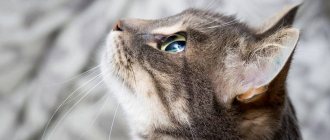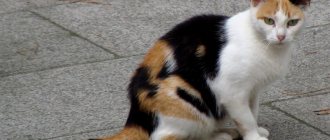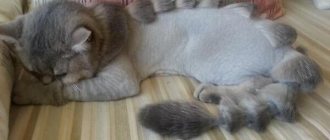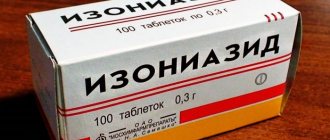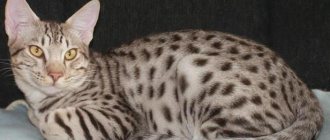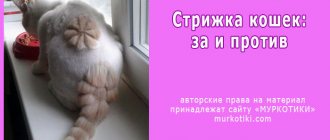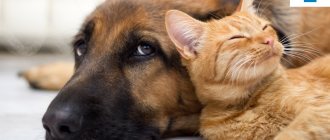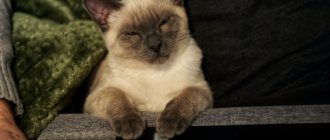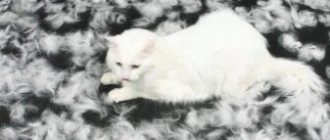Many people want to have a beautiful, fluffy British pet at home, but not everyone knows how to feed a pet properly. Proper nutrition is the key to the health and beauty of any cat, especially the British breed. After all, the condition of the coat, thickness, density and color largely depends on high-quality food.
To ensure that your pet does not have digestive problems, does not lose hair, and feels good, it is simply necessary to provide a balanced diet that contains all the substances necessary for the body.
The cat's diet must be properly selected.
Feeding an adult British cat
The frequency of feeding a British cat depends on the age of the cat. Babies need to be fed at least 6 times a day. At the same time, there is no need to remove food from the bowl. A small kitten should always have access to food to replenish the calories spent in active games and running around. For kittens older than 6 months, the eating schedule is more strict.
They should eat 2 times a day - morning and evening. After eating, the bowl should be hidden or any leftover food should be removed from it. It is important that the cat always has access to clean, fresh water. Especially if the diet is based on dry food.
There are several basic rules for feeding the British breed:
- The animal should be fed only with fresh and high-quality products.
- The food temperature should be the same as the room temperature.
- It is better to grind porridge and vegetables in a meat grinder and mix with meat.
- There should always be clean water next to your food bowl.
- The animal must be fed at the same time.
If the animal eats meat passed through a meat grinder, small balls should be made from the minced meat. After each feeding, the bowl must be washed to prevent bacteria and germs from growing in it. You can't feed Britons hot or cold food.
The animal should be given the opportunity to rest after eating. It is best not to provoke him into playing, but to let him take a nap.
Raw meat and fish on the British menu
All felines are predators. In the wild, animals of this family eat raw, fresh meat, so their diet should not be limited to processed foods, but they should choose wisely.
British cats will not refuse fresh meat.
For Brits, it's worth choosing low-fat varieties. Chicken, rabbit, beef are perfect. Fatty meats, such as lamb or pork, can lead to obesity in your pet and a disruption in its metabolism.
Fresh meat must be frozen for a day before offering it to your cat. This measure will protect against infection by parasites. After defrosting, the meat should be minced, passed through a meat grinder. For children, this operation should be performed twice.
Before giving the meat, it is recommended to pour boiling water over it. This will make it easier for the cat to eat it. Fresh meat should be in the diet every day. For variety, you can use meat by-products.
Ready food
If the owner has chosen dry food as the main food for his pet, he should know a few tips. First of all, it is better to give your preference to premium food. Preference should be given to Premium class feed. The main thing is that the four-legged friend likes it. It is better not to exchange the selected food for other brands. The furry body gets used to one diet, and replacing food can lead to a number of digestive problems. If a cat eats dry food, it must have constant access to clean, fresh water.
How many times a day should you feed
Often nutrition depends on the age of the pet. At a very young age, newborn kittens are fed by their mother. The kitten eats as many times as he wants. From the first month, babies need to be gradually fed, increasing the frequency of complementary feeding. Babies older than a month should eat at least six times a day. For kittens 4-6 months old, it is recommended to have 6 complementary foods per day, while by the sixth month this amount should be reduced to 4. Kittens 6-10 months old should receive food 3-4 times a day. Veterinarians recommend feeding an adult cat 2 times a day. It is better to do this in the morning and evening.
Kittens should be given complementary food as often as possible.
What foods should you feed your Briton at home?
Every pet owner should understand that purebred cats should never be fed food from the common table.
If you decide to feed the animal only natural food, then you need to be patient and understand that you will have to cook separately for the Briton. An incorrect or unbalanced diet can negatively affect the health of a four-legged family member. It is important to understand that not a single British cat can live without meat products . Previously, such food is exposed to low temperatures in the freezer compartment of the refrigerator, where the meat remains for at least two days. Thawed meat does not contain harmful microorganisms or bacteria and is therefore suitable for cats to eat raw. It is advisable to give preference to beef, which is cut together with films and veins. This meat can be given daily. It is better not to include veal in the food of a domestic cat, since it contains virtually no enzymatic substances.
When feeding an animal lamb, pork or game, they must be subjected to heat treatment. Otherwise, helminths or much more serious parasites may appear in the cat’s body. The British also like offal - kidneys, liver, heart or lungs, cut into pieces. Such a meat product cannot be cut very finely so that the pet does not swallow it, practically without chewing. Liver can only be used from beef or chicken, and never from pork.
Boiled fish is beneficial for the health of a British cat. Eating raw fish is undesirable due to the fact that it destroys B vitamins in the body. It is advisable to use marine varieties of fish. But it is impossible for fish to take up a large part of the animal’s food. A castrated animal can be given fish no more than once a month. Chicken meat must first be boiled and bones removed from it, if any. It is better to give it together with broth no more than 3-5 times a week.
The British food can consist of chicken and quail yolks , both boiled and raw. You can mix egg yolk with dairy products and give it to your pet 2-3 times a week. Whole eggs can be cooked like an omelet without adding spices or salt and can also be given to a British cat. Separately, the animal can be fed with fermented milk products. However, veterinarians do not recommend giving milk in its pure form.
Nutrition of British kittens
The nutrition of small kittens must be approached especially carefully. The growth and development of an animal depends on proper nutrition. Kittens should not be given large pieces. They might just choke on them. It is better to grind all food through a meat grinder or blender.
If the kitten eats dry food, pre-soak it with water. Babies should be fed before the family sits down to the table. This will prevent your pet from developing the habit of begging. The table shows the norms of dry food in grams for British kittens:
Table of norms of dry food for kittens up to one year old.
A small kitten aged 1-3 months is fed at least 6 times a day. Some veterinarians recommend feeding 8 times a day. If the diet consists of natural food, the daily intake should be at least 150 grams.
A British baby should eat 4-5 times a day for 4-6 months. The serving size should be increased to 240 grams. From 6 to 10 months, the frequency of feeding should be reduced to 3-4 times a day, the daily norm should be 280 g.
After 10 months, the cat can be fed 2 times a day, and the norm increases to 300 grams. If the animal has a diet of dry food, follow the instructions.
Artificial feeding of British newborns
For feeding very young kittens, there are special formulations that can be purchased at veterinary pharmacies. If it is impossible to use such drugs for a number of reasons, you can prepare similar mixtures at home. British infant formula can be prepared from:
- 250 grams of cream with a fat content of 10% should be diluted with warm water in a ratio of 1 to 2.
- Goat milk is mixed with egg white (4 to 1). The resulting mass must be whipped until smooth.
- Dilute condensed milk without sugar with water in a ratio of 5:1. Add a teaspoon of bone meal to this mixture.
In order not to harm the kitten, you need to feed small kittens strictly in accordance with the recommendations of veterinarians. Experts have developed a number of recommendations:
- The mixture must be freshly prepared. You can store it in the refrigerator, but no more than 6 hours.
- It is necessary to monitor the temperature. It should be 36-37 degrees.
Before feeding your baby, it is recommended to massage the tummy. Such measures improve digestion and add a sense of comfort to the kitten.
Features of caring for a newborn kitten in the first months
Caring for a newborn British baby is a labor-intensive and complex process. Mom gives her furry babies not only food, but also care, protection, and affection. If a kitten has lost its mother, the owner must take over her functions. Otherwise, the baby may simply die.
The main thing is to take care of the kitten’s physical comfort. Hypothermia must not be allowed. It is better to use pillows, blankets, fluffy soft towels. You need to make a house for the kittens. A medium sized box is perfect.
It is better to place it in a quiet, warm place. Before you start feeding, be sure to wash your hands. The immune system at this age is not yet strong, and the animal can catch an infection. If there are several kittens, it is better to keep them together. If any of them develop symptoms of illness, it is better to quarantine him.
Material on the topic: everything about the care and maintenance of British breed cats.
How to understand that a kitten cannot tolerate a particular product
You can understand intolerance to a particular product by the cat’s behavior. The animal stops eating it and ignores such nutrition. Your cat may also show signs of allergies. This may include redness, itching and other symptoms. The cat may begin to itch, hair fall out, and more. If such symptoms appear, you need to eliminate such foods from your diet as soon as possible.
Feeding with natural products
Natural food products are considered more healthy in terms of protein and carbohydrate content with a high content of vitamins, fiber and microelements. It is not difficult to provide such a diet, but it is troublesome, expensive, and you will need to spend time purchasing a variety of products and preparing them. Owners who have enough free time prepare food from natural products for their pet.
The natural nutrition set includes: lean meat with by-products, fermented milk products, sea fish, cereals and vegetables with fruits. Each natural product is processed and prepared according to specific recipes, ensuring maximum preservation of the beneficial content and properties.
Meat
Meat is the basis of the British daily diet, accounting for about 2/3 of total consumption. It must be fresh. Meat products include beef, lean parts of chicken, turkey, and rabbit. To prevent helminth infection, meat products are frozen for 2 days in the refrigerator. The owner gives food to the cat raw, but it is better to pour boiling water over it or boil it. Before feeding, food is chopped into pieces, veins and bones are removed, especially tubular ones from game. It’s good to grind everything into minced meat, it’s convenient to make it in advance, then defrost it in portions. Beef, rabbit, and poultry by-products are added to the meat, which are also pre-treated with cold.
Fish
The British weekly diet contains lean ocean or sea fish, rich in phosphorus and amino acids, present at least 2 times. First, the fish is cleaned of scales and bones, the tail, head, and entrails are removed. The finished fillet is boiled for up to 10 minutes in boiling water, and cold pieces are fed to the pet. Fish choices include hake, cod, pollock, navaga, and blue whiting. River fish with small bones is given in ground form.
Porridge
Porridges from buckwheat, oatmeal, and rice are added to meat products, mixed with boiled or raw vegetables in the form of meatballs in a ratio of 1:10. Cereals contain complex carbohydrates with B vitamins necessary for complex nutrition. Porridges are also cooked in milk or meat broth and included in the diet up to 4 times a week.
Dairy
For a comprehensive diet, the British need fermented milk products, cottage cheese, and cream contain calcium and animal protein. Milk is mixed with bran, which contains fiber; it is beneficial for the cat’s body and is included in the diet up to 3 times a week. The pet does not like dairy products; they are tamed to them gradually, starting with a teaspoon. In adult cats, pure milk may not be digested by the stomach.
Vegetables and fruits
Vegetables, fruits, legumes as a source of vegetable protein, carbohydrates, vitamins and microelements. Not all pets are inclined towards a vegetable menu, so they are mixed with fish or meat products up to 4 times a week. Healthy vegetables such as any kind of cabbage, cucumbers, zucchini, carrots and beets. It is not recommended to include potatoes, onions, and herbs in your diet. And the yolk of a chicken or quail egg, and cat greens are useful to add to the diet.
Nutritional features of elderly and sick British cats
Adults and elderly individuals require special care and nutrition. They should receive a balanced diet, essential minerals and vitamins. Food for such pets should contain little fat and more protein and carbohydrates. Britons' tastes can change as they age. They become capricious and picky. They often refuse their usual food.
This can happen due to the presence of chronic and age-related diseases. An elderly body absorbs vitamins, micro- and macroelements worse. This is due to deterioration of absorption of the stomach and intestines. In this case, it is necessary to include additional vitamin and mineral supplements in the diet. To slow down the aging process of the body, the animal should receive:
- vitamins B, E, C;
- beta-carotene;
- glucosides.
An older animal should be seen by a veterinarian and its health status checked regularly. The specialist will adjust nutrition in the right direction depending on individual problems.
Mr. Cat recommends: When to introduce complementary foods
Veterinarians advise introducing complementary foods starting at three weeks. At this time, the kitten can gradually accept new food and wean itself off mother's milk. To reduce the body's stress in response to the arrival of an unknown product, complementary foods are introduced gradually.
Start with small amounts and watch the animal's reaction. If the kitten refuses to eat, you should not continue to force feed it.
Features of the manufacturer's cat nutrition
The diet of a British stud cat is practically no different from the diet of an ordinary cat. For better health, you can introduce additional supplements of vitamins and elements. Some professional breeders choose food with a high protein content for such individuals.
What to feed a cat after castration
After the operation itself, the animal must be switched to a new diet. This is necessary to reduce the cat's stress. The time and amount of food remains the same. This condition is necessary for stable digestion. Often neutered individuals begin to gain weight.
To do this, you need to gradually reduce the amount of food. If the animal receives dry food, its weight should be 30-40 grams. For wet food – 50 grams.
You need to monitor your cat's weight and weigh the animal regularly. You can calculate the exact amount of feed from special tables developed by specialists in breeding and caring for British dogs.
It is recommended to play with neutered animals more often. The animal must have physical activity. This will prevent obesity.
To determine the degree of obesity, you can stroke the animal on the back and hips. In this case, all bones should be palpable; if this does not happen, then the cat has excess weight that needs to be dealt with.
British diet
While Britons are small, their diet differs from that of an adult animal.
It is important to feed your British kitten correctly from the very beginning so that the baby does not have problems with the gastrointestinal tract. So what foods should you include in your pet's menu?
Nutrition at one month of age
As a rule, at the age of one month, British kittens are still fed breast milk. But sometimes it happens that the baby is torn from his mother at such an early age, then he has to be fed formula.
In order for the body to restructure itself, it is best to combine food with food and formula in the first days of the transition. It is better to ask the breeder what kind of mixtures to feed, since it is advisable to give the baby the same foods throughout the entire transition period, so as not to subject the British dog’s delicate stomach to additional stress.
shutterstock
A smooth transition to solid food is carried out in several stages:
- at the age of 1 month you need to feed your baby a little dairy products, but raw cow's milk can cause stomach problems, so it is better to use baby food mixtures or baby milk porridges;
- It is best to start feeding your British cat natural meat with ground boiled minced beef or even more tender veal;
- gradually add semolina porridge or oatmeal or buckwheat porridge with milk to your British baby’s menu;
- It is better not to give fermented milk products to a kitten under 7 weeks of age;
- at the end of the transition, you can include cottage cheese in the diet, you can feed more yogurt;
- It wouldn’t hurt to feed your pet boiled liver (beef or poultry);
Month-old kittens eat often, but not much. One serving should be 20-30 grams of food, and in just one day you should get up to 100 grams of food. The most important thing is to feed them regularly.
British menu at two months
At the age of two months, kittens finally switch to regular cat food. In addition, they are at an age when they can already walk perfectly and begin to explore the vast world around them.
It is very important to eat right during this period. Your pet should get the energy reserve for active movement and rapid growth from a complete healthy diet.
The menu should include the following products:
- dairy and fermented milk products: porridge with milk, cottage cheese, yogurt;
- boiled meat (beef, veal, chicken; rabbit);
- canned cat food (special baby food);
- you can feed the kitten egg yolk (only the yolk, the white can be harmful);
- baby food and baby milk porridges.
It is important that the kitten always has a clean food bowl. You need to wash it after every feeding.
Also, there should always be clean and fresh water nearby (it needs to be changed at least twice a day). You must feed the kitten, and he will drink on his own.
shutterstock
What to feed a British baby at three months?
The kitten grows and its diet changes and becomes more varied. The owner should worry about adding more variety of food products to the pet's menu.
The diet of a three-month-old British kitten should include:
- fish products: this should be fillet, thoroughly cleaned of bones (it is better to take sea fish, it has much less bones);
- You can add dry food soaked in water or milk to your baby’s menu (at this age - no more than once a day);
- although cats are predators, at the age of three months their diet should be fed with vegetable products, which are served boiled along with chicken, turkey or beef meat;
- Infant formula and porridge can be eliminated by replacing them with natural fermented milk products (kefir or yogurt) during the transition period, but you should not feed your baby with store-bought products.
At the age of three months, the kitten's meals should be just as frequent - at least 4 times a day, and the portion size can be increased.
Menu for four months
The baby is growing and looks less like a tiny ball of wool. His body has already adapted to adult food. Your pet may eat less often, but the portions should be larger.
At this stage of growth, dry food can be included in your pet’s menu in a volume of at least a quarter of the total. It is better to use specialized varieties of dry food that contain an optimal balance of beneficial nutrients and microelements.
The young body of a cat at this age needs proper, healthy, balanced nutrition more than ever.
Nutritional features of a pregnant cat
A pregnant cat needs special and enhanced nutrition. The diet should include veal, chicken, and beef. Sometimes you can feed fish, as long as there are no bones in it. It is recommended to give the “future mother” dairy products - kefir, cottage cheese, sour cream and others. There must be vegetables. This is necessary to ensure that the body receives the necessary vitamins.
Bone meal can be used as an additional additive. Sometimes pregnant cats may have problems with bowel movements. To eliminate this problem, broths containing meat and warm milk are introduced. Sausage, sweets, and foods with seasonings should be completely excluded. Such foods can cause diseases such as kidney stones and heart failure.
A nursing cat needs an enhanced diet.
What to feed a cat after giving birth
During the first few days, the cat may completely refuse to eat. There's nothing wrong with that. The main thing is that the cat drinks water during this period. Mom needs to give food more often - 5-6 times a day. Veterinarians advise switching the cat to liquid food in the first weeks.
New products are gradually being introduced - meat, vegetables. If the cat is on a ready-made diet, many manufacturers have specially formulated foods in their product line.
How to exclude urolithiasis
The cause of urolithiasis (in both humans and animals) is stone-like formations in the urinary tract and kidneys. After castration, the animal's urinary canal (urethra) narrows, which contributes to its obstruction. This means that if there are stones, they will not be able to leave the body naturally.
Therefore, the diet of castrated British cats should contain a minimum content of microelements, which can contribute to the appearance of kidney stones. These are phosphorus, calcium and magnesium.
How and what to feed a neutered cat correctly
What type of nutrition is acceptable for such a “family member”: dry food, canned food, or natural food? There is no clear answer to this question. If you give preference to dry cat food, then the main rule is to stick to one brand. Now on the pet food market there is a huge selection of their manufacturers and various selections, including for neutered cats.
True, there is no significant difference between specialized and ordinary food; when purchasing, you just need to pay attention to the presence of components that oxidize urine (they reduce the likelihood of stone formation). It is better to take premium or super premium food.
Another rule when feeding dry food is for the animal to drink a large amount of water (about 3 times more than the food it eats).
If the cat does not like to drink water, you need to give the food soaked or switch to natural food.
In this case you can use:
- poultry meat,
- beef,
- carrot,
- cabbage,
- offal (liver, lung, heart, chicken gizzards),
- porridge.
Baby puree with beef and vegetables is also perfect. Kefir and cottage cheese are also needed
It is important for a cat to eat a varied diet. You should do this: alternate dry food with canned food, and with a natural diet, use dry food as a supplement
Once the brand of food has been finalized, it is not recommended to change it. It is better to use a product from well-known and trusted manufacturers, because... They are constantly improving the composition of their feed by conducting various additional studies.
The use of fish in the diet of castrated cats is strictly prohibited! Phosphorus contained in it in large quantities is very harmful to them.
Strong and healthy teeth
To ensure that your cat’s teeth remain healthy, special substances are added to elite foods to prevent diseases in this area. With natural feeding, they will be replaced by massagers for teeth and gums, which are available in a large assortment in pet pharmacies and pet stores. There you can also purchase a complex of vitamins C, E and B, which is necessary to maintain the vitality of your pet.
The recommendations given are quite general. A veterinarian will provide a full consultation on proper nutrition for a neutered cat, and he will also advise what to do if the cat does not want to eat its usual food.
Additional Health Support Factors
It is important and necessary for a castrated cat not only to eat properly, but also to be more active. Having no sexual instinct, such an animal focuses on food - it begins to eat a lot and often
This diet, combined with a sedentary lifestyle, can lead to obesity in your pet.
To prevent this from happening, you need to feed the cat often, but in small quantities. You definitely need to give him a weekly fasting day. If the cat has nevertheless gained weight, then you should make his diet lower in calories and increase physical activity (in the form of frequent outdoor games). Excessive lethargy of the purr after surgery is a reason to visit a veterinarian, who can advise him on a course of vitamin B 12 and sex hormones.
The recommendations given are quite general. A veterinarian will provide a full consultation on proper nutrition for a neutered cat, and he will also advise what to do if the cat does not want to eat its usual food. A properly balanced diet and a certain amount of physical activity are the key to ensuring that your pet remains healthy, cheerful and active after the castration procedure for the rest of its life.
Varieties of food
Food for the British is divided depending on cost into the following classes:
- economy;
- premium;
- extra-premium;
- special feed.
These feeds differ in their composition and the quality of the products used for their production.
Interesting material about British cats: what is their character and what they are like.
Economy class food
The British are quite picky eaters.
Food in this category is known to everyone thanks to active advertising. They do not contain even half of what is required for a complete, balanced diet for an animal.
They are produced from the lowest quality raw materials. Their main ingredient is cereals. Offal is used as meat.
Such foods are harmful to the health of British cats due to the lack of all necessary vitamins, proteins, and minerals.
Premium class for cats
They contain a higher percentage of meat, mainly chicken. Most of the composition is also cereals, corn or rice. These foods contain more vitamins and other essential elements.
Extra premium food
This category is rarely advertised. It is known to professionals and people who are picky about the quality of their pet’s food. Such food is sold in specialized stores. The percentage of meat in such brands is much higher than in regular ones. There is a balance of proper nutrition here.
Holistic food
Holistic cat food is sold in veterinary stores. It contains real high-quality meat, as well as special additives. Holistic foods are considered the best among ready-made diets. They do not use plant sources of protein. For better preservation, no artificial preservatives are used. Interesting nuances of feeding cats can be found in the video below.
Brief history of the breed
The British Shorthair breed has been around for a very long time. Today it is no longer possible to find any documents about how she ended up in England. According to one version, her ancestors were brought to the island by Roman conquerors.
True, the graceful, long-legged cats of the legionnaires, who protected food supplies from ship rats, were more reminiscent of Egyptian animals rather than the tightly built, round-faced modern British.
Over time, freedom-loving individuals spread throughout the British Isles and began to mate with local wild relatives. Their descendants lived next to people for several centuries and regularly destroyed rodents. For a long time, these cats were undeservedly deprived of attention, and only in the second half of the 19th century did people begin to show interest in them. They were first demonstrated at the London Exhibition on July 13, 1871, and from that moment they gained popularity.
After the Second World War, the British population declined catastrophically. To save the breed, cats began to be crossed with Persians, Chartreuxes and Russian Blues. Because of this, they did not receive recognition from leading felinological organizations for a long time.
In 1967, the American Cat Association listed them under the name "British Blue". In Russia they learned about the breed in 1980.
Rules for choosing food
British breed cats are not too picky about the taste of food, so food should be chosen based on the composition, budget and health of the animal. Specialized lines of food for the British contain important microelements; the ratio of products is selected taking into account the needs of representatives of this breed.
You should not mix different types of food (dry, wet) from different manufacturers. You can alternate them. When buying an unfamiliar brand of food, it is better to take several small packs instead of a large economy pack and see how your pet reacts to the new diet.
Diet and feeding regime of the British
Adult cats of the British breed are fed no more than once a day in the summer heat, and twice a day in all other seasons.
It is very important that the cat is fed according to a schedule. Balanced cat food per kilogram of weight may consist of the following ingredients:
- beef meat – 20 Gy;
- soft cheeses – 10 G;
- cereal – 4 Gy;
- sunflower oil – 0.2 G.
By adhering to proper nutrition, the cat will live a long time without illness, without visiting a veterinarian, delighting its owners with a grateful purr.
General Tips
If the animal’s menu consists of natural products, then vitamins must be added to the food. In industrial feeds they are found in optimal quantities. The complexes should include:
- vitamins of group B, A, E, D;
- microelements;
- choline, taurine;
- amino acids, fatty acids;
- Brewer's yeast.
At the pharmacy you can buy fish oil, B vitamins, Omega-3, Omega-6, and feed tricalcium phosphate.
When introducing new food products into the diet, it is very important to look at the cat’s reaction, since each animal has individual characteristics and may not tolerate some components of the food.
Interesting Facts
During the existence of the breed, a lot of interesting things happened to it:
- The prototype of the Cheshire cat, described in Lewis Carroll's work "Alice in Wonderland", was British.
- Instead of the usual meowing, representatives of the breed make unusual croaking sounds.
- In the last century, blue color was recognized as the only correct color. A British cat of a different color was considered a cull.
- In the homeland of the breed it is simply called shorthair, which means “short-haired”.
Dry food and canned food
It is most often chosen by owners who do not have time to prepare natural food. In this case, it is necessary to increase the amount of water consumed by the animal. Experts recommend alternating industrial food with natural food, but the proportions should be equal.
Advantages of dry food
This food has a number of benefits. Breeders include:
- Availability.
- Low packaging price.
- Long-term preservation of an open package.
- Many varieties.
- Cleaning your cat's teeth from plaque.
For many pet owners, the main factor when choosing cat food is the low price of food, although such food is of lower quality and healthy.
Disadvantages of the finished product
Experts include the following disadvantages of this type of nutrition:
- use of low-quality raw materials (bones, horns, feathers) in the production of feed;
- a large number of chemical additives in economy class products;
- cat’s dependence on dry food due to special additives;
- low energy value.
Paying attention to the quality of the food, you should find out when the food was made and for what age it is intended.
Important! Regardless of the type of prepared food chosen, you need to give the animal natural products.
What a British cat shouldn't eat
It is also important to understand what you absolutely cannot feed an animal:
- Low quality dry food like Whiskas, Friskas, Kitiket. They, of course, are not as expensive as premium products, but such savings will not bring benefits. The composition speaks for itself - horns, hooves, feathers, aromatic additives.
- Food from the master's table. By the way, this is a common mistake of many owners who lovingly feed furry beggars borscht, cutlets, canned food, and sausages.
- Although meat is very good to include in the diet, not all types are equally healthy. Thus, fatty varieties are strictly contraindicated. For example, lamb.
- Under no circumstances should you feed Spices are also not welcome.
- Vegetables and fruits are recommended for furry pets, but not all. Eggplants, for example, are even recognized by veterinarians as dangerous to cat health. Just like onions, garlic, potatoes, citrus fruits.
- It is theoretically possible to eat river fish, but in reality there is a high risk of small bones getting into your pet’s body.
How to choose the right kitten
It is better to buy a British dog from trusted breeders or in specialized nurseries that breed this particular breed. At the time of sale, the kitten must have a certificate confirming its origin and a veterinary passport with notes on vaccinations.
Little Britons should not show signs of aggression or fear. Cats should be active, playful and moderately curious. Healthy British babies have clear eyes, soft bellies, clean coats and smooth skin without scratching or redness.
Kitten care
Until the age of three months, little British babies live with their mother. By the time they move to a new home, kittens of this breed are already completely independent. They eat many foods, are accustomed to scratching posts and go to the litter box. Therefore, the owners can only show the pet where the bowls with food and the pot with filler are.
To make the little Briton comfortable, they provide him with a place to sleep. For safety reasons, wires, household chemicals, indoor plants, fragile and small things are hidden from the kitten.
Caring for British women
Caring for short-haired cats is not difficult. It is necessary to take into account some nuances so that your pet always looks presentable:
- The coat requires careful care, so at least twice a week you need to comb the cat with a massage brush (slicker brush) to remove lost hairs. It is enough to wash a British breed animal no more than twice a year.
- Claws. It is quite problematic to properly grind a pet's claws even with the help of a scratching post. They need to be trimmed at least once a month. You can remove no more than 1⁄2 the length of the claw.
- Ears. The ears must be examined 2 times a month. If dirt has accumulated, you need to remove it with a cotton swab dipped in warm boiled water. The open part is lubricated with Vaseline or baby cream.
- Eyes. Dark discharge always accumulates in the area of the eyeballs. They need to be removed daily by wiping the eyelid with a damp disc from the outer corner to the nose.
- Teeth. It is necessary to examine the oral cavity regularly, as tartar may form. To prevent this phenomenon you need to buy a special product. The animal must be accustomed to the procedure from early childhood. Removes plaque and dry food well. It needs to be given constantly, and not for the purpose of removing dental plaque.
There will be no problems in the full development of the British if you care for them in a timely and competent manner.
Breed description, standards, appearance
British cats are massive animals, not without agility and grace. Their calling card is their thick, plush coat and full, rounded cheeks.
The breed standard was formed back in the 19th century and has remained virtually unchanged since then.
Dimensions and weight
British cats are medium to large in size. They have pronounced sexual dimorphism, so males are noticeably larger and heavier than females.
A British breed cat weighs between 3.5-6.5 kg. The cat's weight reaches 5.5-9 kg.
Anatomical characteristics
A typical representative of the breed should look consistent with the official description. The British Shorthair cat ideally has the following characteristics:
Important! The British cat is a straight-eared cat. Folding indicates that the animal is not purebred or belongs to a different breed.
Color and coat type
British cats are covered with short, elastic, dense fur that feels like plush. A thick undercoat is hidden under the shiny awn. The standard allows for several dozen variations in the color of British cats.
The most common colors found in the breed are:
On a note. White Britons are predisposed to congenital deafness. Therefore, it is impossible to cross two representatives of the breed with each other with this color.
Possible breed defects
Exterior defects in the presence of which a British Shorthair cat may be recognized as not meeting the official standard:
Older British people
At 9-10 years old, cats are considered elderly. Their activity decreases and special nutrition is required. Dietary food lines are produced for them. Preference is given to canned food.
It is necessary to transfer a British cat to special feeding only after consultation with a veterinarian, since at this age many pathologies develop that require diet correction.
Pros and cons of the breed
Like any other cat breed, the British Shorthair has both positive and negative traits.
ProsCons
| Cleanliness | The need for a balanced diet |
| Friendliness | Predisposition to certain diseases |
| Easy to care for |
The British Shorthair is an attractive cat with aristocratic habits and developed intelligence. This is one of the few animals whose appearance completely matches their character.
The smiling, phlegmatic Briton, who looks like a plush toy, will be an ideal pet for both families and single people.
